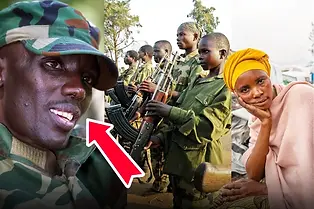Heading 2
Heading 2
Heading 2

Rwanda’s Direct Role in Congo’s Conflict: 2025 UN Reports on DRC
Rwanda's army is occupying Congo, looting minerals, and committing war crimes under the cover of M23 rebels. The UN has exposed it all
7/14/25, 6:22 PM
In 2025, the conflict in eastern Congo reached an alarming tipping point, not just due to rebel gains, but because of direct and sustained military operations by the Rwandan Defence Forces (RDF). While Rwanda continues to deny involvement, the latest UN Group of Experts Report on the DRC paints a stark picture involved Rwanda's and M23's war crimes. Rwanda is not just an enabler of violence in the Congo; it is an active combatant and benefactor of the war.
This investigation explores five pillars of Rwanda’s direct involvement, exposing the systemic violations of international law and their catastrophic impact on civilians and regional peace.
1. Illegal Deployment of Rwandan Troops
The RDF has engaged in systematic and repeated incursions into Congolese territory, not as a rogue actor, but under high-level state direction. The report provides damning evidence that between January and February 2025 alone, over 6,000 RDF troops were operating inside North and South Kivu, with reinforcements brought in from Rwanda to capture major cities like Goma and Bukavu
Far from covert operations, the RDF’s occupation involved high-tech warfare: airstrikes, armed drones, short-range air defense systems, and jamming of GPS systems, often disrupting humanitarian and civilian flights
These invasions violate Article 2(4) of the UN Charter and constitute what the UN calls “acts of aggression.” Rwanda’s assertion that it's defending itself from the FDLR is contradicted by the sheer scale and scope of these invasions, more about control than defense.
2. Command and Control Over M23 Rebels
The M23 rebel group, or AFC/M23 as currently structured, is not acting independently. Intercepted communications, verified interviews, and drone footage confirm that Rwandan generals are issuing direct orders to M23 battlefield units, including instructions on when to seize or withdraw from territory
Key Rwandan military figures involved in command operations include:
a Sanctioned Gen. James Kabarebe – long-time M23 architect
a sanctioned Gen. Ruki Karusisi – RDF Special Forces commander
Gen. Vincent Nyakarundi – Army Chief of Staff
Gen. Patrick Karuretwa – military judge overseeing M23 coordination
This vertical command structure nullifies the idea that M23 is a Congolese-born rebellion. It is, in effect, a shadow army of Rwanda, operating under Kigali’s strategic direction.
3. Mineral Looting and Cross-Border Smuggling
Once territories fall under M23-RDF control, they are stripped for resources. The UN report outlines a clear pattern: coltan, gold, and cassiterite are extracted in sites like Rubaya and Kalehe, then smuggled to Rwanda through formal border crossings like the Grande Barrière and Ruzizi I, often at night to avoid detection
Fake documentation is used to make these “blood minerals” appear Rwandan in origin. In one documented week alone, 195 tons of minerals crossed into Rwanda via coordinated truck shipments
These smuggled minerals are then mixed with Rwanda’s own output and sold into global markets, effectively laundering conflict resources into legitimate supply chains. It’s a sophisticated operation that compromises international traceability schemes like ITSCI.
4. Arms Transfers in Violation of UN Sanctions
Despite a UN arms embargo, Rwanda has continued to supply M23 with:
Armed drones (e.g., TB2 Bayraktar)
SHORAD air-defense systems (e.g., Yitian TL-6)
Uniforms and ammunition with serials removed to hide origin
Notably, guided missiles fired from RDF positions have struck UN peacekeepers and killed civilians in refugee camps and hospitals. These targeted strikes, including a missile that killed a MONUSCO peacekeeper in Sake, are considered war crimes under international law
5. Crimes Against Civilians and Peacekeepers
Where RDF and M23 forces go, atrocities follow. The UN documented:
Extrajudicial executions (200+ civilians in Goma alone) see the latest Human Watch report on documented war crimes by M23 crimes.
Mass torture, rape, and kidnappings
Shelling of IDP camps and hospitals
House-to-house raids and enforced disappearances
Targeted killings of civil society leaders and journalists
The RDF and M23 also conducted armed hospital raids, dragging out wounded civilians and suspected soldiers, some of whom were executed within the compounds
When UN investigators attempted to access these areas, they were threatened, blocked, or misled, with M23 forces cleaning up bodies and sanitizing evidence before arrival. This systematic obstruction is designed to erase the paper trail of war crimes.
What This Means for Congo and the World
This is not a proxy war. It is a state-sponsored occupation with geopolitical ambitions. Rwanda’s objectives, as confirmed by UN sources, include:
Securing mineral wealth
Installing a loyal political order
Creating an autonomous Rwandan-aligned buffer zone in Eastern DRC
The implications are massive:
Humanitarian catastrophe: Over 700,000 displaced in Goma alone.
Threat to UN credibility: Peacekeepers under fire from a UN-contributing state (Rwanda).
Global supply chain risks: Conflict minerals laundered into clean markets.
A Peace Deal With No Peace
Any future agreement between Rwanda and the DRC must start with accountability. The evidence is no longer ambiguous. Rwanda’s military, acting under high-level state orders, has violated Congolese sovereignty, fueled rebel war crimes, and exploited natural resources under the barrel of a gun.
To ignore this is to legitimize aggression as diplomacy.
Sources:
Keep Reading







